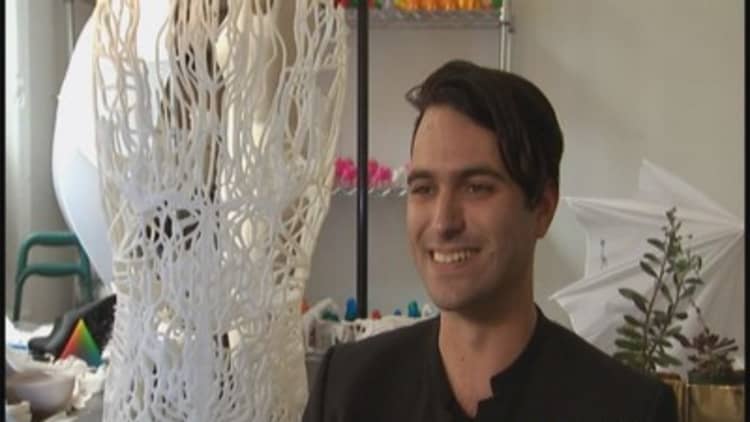Architect-turned-designer Francis Bitonti wants to find out what happens when cutting-edge technology meets fashion.

The Brooklyn-based founder of Francis Bitonti Studio gained notoriety in 2013 after his 3-D printed dress for burlesque star Dita von Teese pushed the boundaries of what many thought the technology could do.
3-D printing was initially embraced by companies solely as a prototyping tool, but Bitonti said he always saw it as more than that.
Read MoreSlidehow: Lingerie Fashion Week
"In 2007, I was talking about this as a production technology, and everybody thought I was crazy," he said.
As printing and its underlying software continue to improve, more people are taking notice. After pairing up with Adobe Systems for his latest work, a pair of shoes dubbed Molecule, Bitonti is more convinced than ever.
We're achieving material effects we couldn't do before. Not only could we not do it with 3D printing, but we couldn't do it with any other type of manufacturing.Francis Bitontidesigner
"There was a time where I did need to convince people, but I have tangible proof now," he said. "That's the kind of work we're most excited with, because that's where we're achieving material effects we couldn't do before. Not only could we not do it with 3-D printing, but we couldn't do it with any other type of manufacturing."
The advancements have been particularly exciting for the fashion industry, an industry where some see buying a brand as buying into a lifestyle. But with the amount of customization 3-D printing provides, Bitonti plans to capitalize on a younger clientele by offering an alternative to mass production.
Read MoreSlideshow: New York Fashion Week Spring 2015
"These luxury brands have had a really hard time targeting millennials," he said. "If you think about it, it's because they grew up with the entire world being built around themselves. We're going to have to offer that experience through material things if you're going to relate to that demographic, and anybody who can't, as soon as the millennials grow up, there's nothing left for you."
The reality is, though, that what Bitonti achieved with additive manufacturing, as 3-D printing is also known, is but just one example of the strides the technology has made in recent years.
The results have far-reaching implications for a struggling U.S. manufacturing sector. According to a September report from employment analysis firm Wanted Analytics last month, the number of job postings requiring 3-D printing skills is up almost 2,000 percent over the last four years, and 3-D printing was the most sought-after skill for 35 percent of all engineering job postings over the month prior.
For Bitonti, it's just the beginning. "It's going to make more jobs, and I think it's definitely going to bring manufacturing back to the United States," he said. "We're leading development right now on this type of production. Nobody else in the world is as far along as we are."

